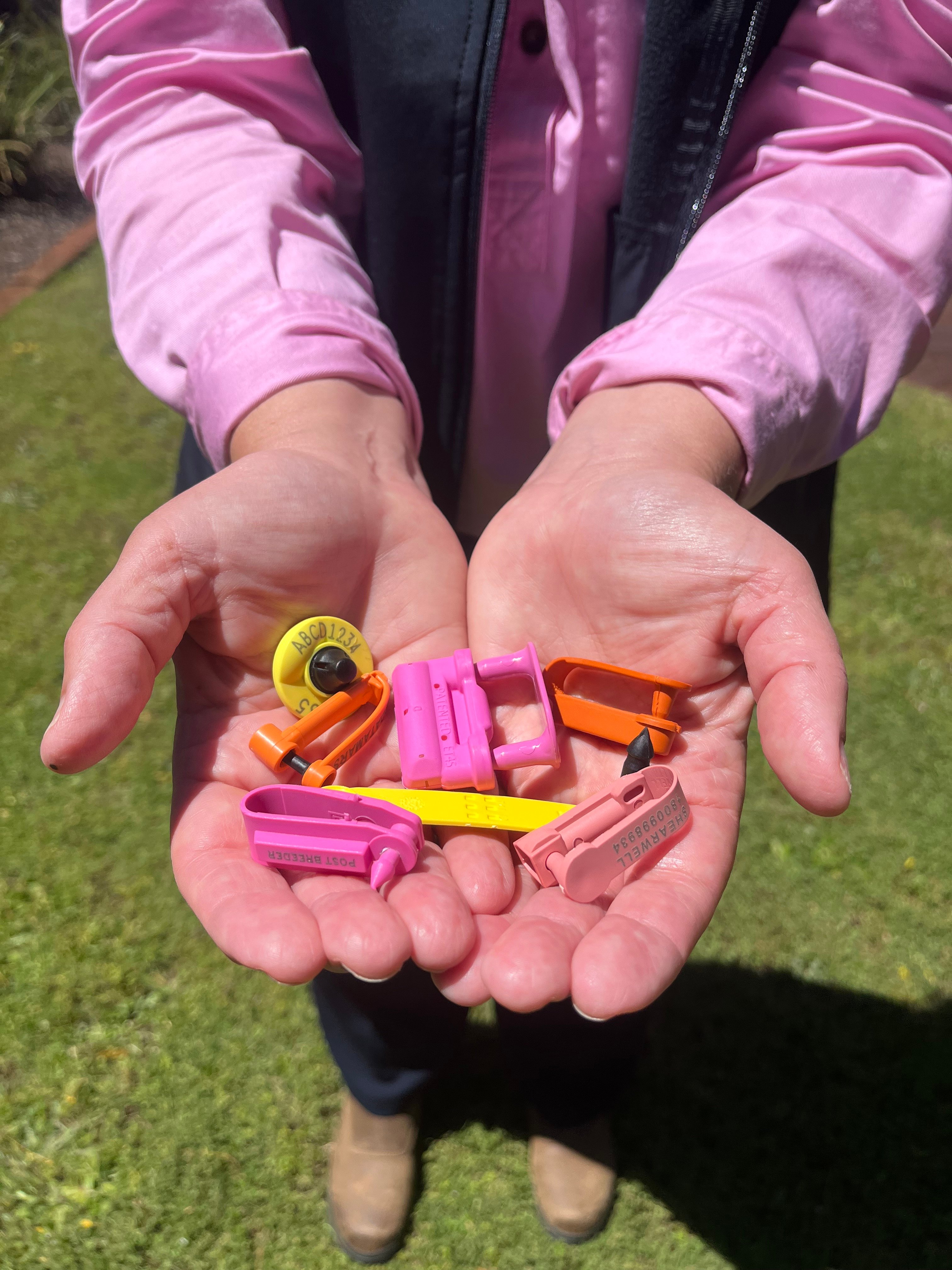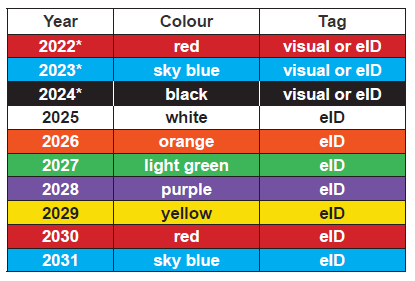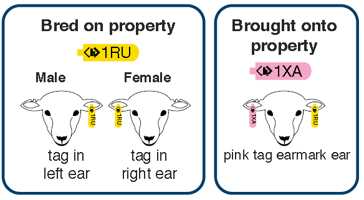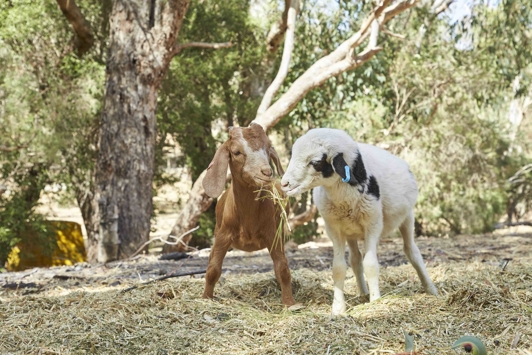The adoption of mandatory electronic identification (eID) for sheep and goats is a way of improving traceability practices for more efficient management of disease outbreaks, food safety issues and market access.
Transitioning to electronic identification
Transitioning to eIDs, allows for the individual identification of animals, as they contain a microchip, which carries a unique identifier for each animal as it's scanned. Each movement an animal makes between properties can be electronically recorded, making it quicker and more accurate to trace the movement of sheep and goats across the market chain.
The implementation of eIDs allows for more precise tracking using the National Livestock Identification System, enabling individual animals to be traced rather than just mobs or consignments. The NLIS is a traceability system, which uses identified livestock and properties to record livestock movements on a central database.
Resources and support
On this page you’ll find resources to help navigate the transition to using sheep and goat eIDs in WA, including:
- What’s changing and when.
- Frequently asked questions.
- Industry-led webinar recordings.
If you’re seeking support with the transition to eIDs for sheep and goats in WA, please contact our team at 1300 926 547 or email eIDTeam@dpird.wa.gov.au
Timeline for implementation
Each state in Australia is approaching the transition to eIDs slightly differently. In WA, we’re taking a staged approach as shown below.
| eID tagging | eID scanning | ||
| Before 1 January 2025 | From 1 January 2025 onward | From 1 July 2025 onward | From 1 July 2026 onward |
| Sheep and goats born before 1 January 2025 do not require eIDs unless leaving a property from 1 July 2026 onward. | Sheep and goats born from 1 January 2025 onward, require eIDs before leaving their property (or within 6 months of birth). | Saleyards and abattoirs are required to scan all sheep and goats with eIDs. | All other properties or facilities must scan all sheep and goats with eIDs upon arrival. |
Discounts available
Through the WA Government's Tag Incentive Payment (TIP) Scheme, there has been an annual $0.75 discount on National Livestock Identification System (NLIS), year-of-birth eID tags since April 2023.
The current scheme continues for white year-of-birth eID tags until 31 December 2025.
From 1 January 2026, the TIP Scheme will be expanded to provide a $0.60 discount on NLIS accredited orange year-of-birth tags as well as pink and yellow eIDs. This scheme will end on 31 December 2026.
National adoption of eIDs for sheep and goats
While the electronic tagging of cattle became mandatory in Australia in 2005, the identification of sheep and goats is currently via a visual ear tag identification system in all Australian jurisdictions except Victoria.
On 9 September 2022, Australian agriculture ministers agreed to a National Implementation Plan for the nationwide implementation of sheep and goat eID tagging and tracing commencing from 1 January 2025.
In WA, the Biosecurity and Agriculture Management (Identification and Movement of Stock and Apiaries) Regulations 2013 set out the requirements for the identification and movement of sheep and goats.
Community engagement
Throughout the transition period, the department’s Sheep and Goat eID team has engaged with producers, saleyards, abattoirs and industry bodies to inform and educate stakeholders of the changes underway. In late 2024, the regulations to mandate sheep and goat eID were amended via a consultation process to mandate the use of electronic identification technologies and practices for sheep and goats within WA.
FAQs
Electronic identification (eID) tags, also called ‘eIDs’ or ‘eID devices’, allow for identification of individual animals. They are species-specific.
Each eID tag has unique internal and external identification numbers. The internal number is a 16-digit serial number called a Radio Frequency Identifier (RFID number) which is contained within an RFID microchip inside the eID tag.
The external numbers work in a similar way to the currently used visual (mob-based) tags: the first 4 letters represent your PIC, manufacturer of the device, the species to which the eID tag corresponds and a final sequence of numbers that represent a serial code (and are customizable) by the producer/purchaser.
Within the National Livestock Identification System database, the RFID number and the NLIS ID are linked to each other, to uniquely identify individual animals. RFID technology has been used very successfully for many years in livestock, such as cattle, as well as domestic animals such as cats and dogs.
When eID tags are purchased, the manufacturer will link each eID to the relevant PIC of the purchaser in the NLIS database.
WA Biosecurity Agriculture Management (Identification and Movement of Stock and Apiaries) Regulations 2013 require that only eID tags approved under the NLIS are used to identify sheep and goats for traceability purposes in WA. All animal identification used under the NLIS must be approved by Integrity Systems Company (ISC) under the NLIS Animal Identification Technology (AIT) Approval Program before an NLIS logo licence is granted.
A list of NLIS-approved eID tags is available on the ISC website.
Electronic identification has proven to be a more efficient system for tracing stock movements than the current visual mob-based system used for sheep and goats. The technology has been used successfully for sheep in Europe, and in cattle in Australia, for many years.
In addition, traceability is becoming increasingly important to key customers in export markets, as a result, our international competitors are enhancing their traceability systems. To stay competitive in these markets, both industry and government at state and national levels agreed, in 2022, to transition to mandatory electronic identification for sheep and goats.
NLIS (Sheep and Goats) as a mob-based system was fully implemented in mid-2010. Since then, this system has matured and our markets are more stringent in their traceability requirements. Hence the need to introduce a more accurate and efficient traceability system for sheep and goats.
The introduction of mandatory electronic identifiation of sheep and goats will:
- provide more accurate and timely traceability of sheep and goats.
- reduce time delays to manage an emergency disease or residue incident.
- reduce the number of sheep and goats and producers impacted (including animals destroyed) in response to an emergency disease.
- reduce the time that Australia is restricted from export markets following an emergency disease or residue incident.
For more information on the benefits of switching to electronic identification see the following resources:
- The 5 whys on electronic identification eID tracing
- A short video - Where’s Woolly?
When one or more sheep or goats (stock) are physically moved between properties with different PICs, a transfer must be completed on the NLIS database. In most circumstances, it's the responsibility of the receiver of the stock to complete this update, however, saleyards, export depots, abattoirs and pounds must scan stock both on and off their property.
The table below shows the responsibilities of producers (owners or agents acting on behalf of owners) and property operators in relation to who must update animal movement in the NLIS database in line with mandatory eID regulatory requirements.
|
Responsible person |
Responsibilities under the Regulations |
|---|---|
|
Purchasers (owners) or livestock agents acting on behalf of owners |
|
|
Holding yard operators, including feedlots, showgrounds and vet practices |
|
|
Saleyard operators |
|
|
Abattoir operators, including pet food processing centers |
|
|
Export depot operators |
|
|
Pound operators |
|
See the Regulations for mandatory reporting timeframes.
The Regulations require sheep and goats to have an NLIS-approved identifier applied to them before they leave their property of birth or before they reach 6 months of age, whichever occurs first.
The following rules apply:
From 1 January 2025
Sheep and goats born on or after 1 January 2025 must be identified with an eID tag before leaving their birth property or once they reach 6 months of age (whichever occurs sooner).
From 1 July 2026
All visually tagged sheep and goats must be identified with an eID tag before leaving a property.
Individual movements of all sheep and goats identified with eID tags must be recorded on the NLIS database.
If you have old stock (born prior to 1 January 2025) that have been fitted with a visual tag, rather than an eID tag, they will only require an eID if departing your property after 30 June 2026. If they are departing your property prior to 30 June 2026, they do not need to be eID tagged.
If you need to eID tag your old stock, use a:
- Pink eID tag to identify stock not born on your property, or
- Yellow eID tag if born on your property.
Do not eID tag stock that already have an eID, as sheep and goats only require one eID tag for life.
If you bring old stock onto your property that already have eID tags, you do not need an additional eID tag.
If a sheep or goat with an eID dies on your property or in transit to your property, you must update the NLIS database within 48 hours of finding the deceased animal.
See ISC website for how to register deceased livestock on PIC guide.
For sheep and goat producers, the primary change will be the requirement to use NLIS-approved eID tags instead of NLIS-approved visual (mob-based) tags. This means you will be required to purchase NLIS-approved eID tags and an eID applicator.
There is no obligation for producers to purchase eID equipment, eID tags are automatically uploaded to the database by the manufacturer and don’t need to be activated.
Other equipment may be required, depending on your property-to-property transfer activity and if you plan to collate individual animal data. For example, access to a scanner will be necessary if you move stock between properties with different PICs, or if you are purchasing stock privately without the use of an agent.
Using eIDs
Electronic identification devices (eIDs) allow individual identification of animals. These devices contain a Radio Frequency Identifier (RFID) microchip that can be read via a handheld scanning wand or panel reader.
Each device has a unique internal serial number linked to an external code (NLISID) to provide the unique identifier associated with the animal that is tagged. The RFID is like the VIN of a car and the external NLISID is like the numberplate – they both identify and can be used to trace the owner of a vehicle.
For livestock, eIDs include:
- ear tags (sheep, goats, cattle)
- hock bands (goats only)
- rumen boluses (cattle only).
RFID and eID technology have been used successfully for many years in livestock such as cattle and companion animals such as dogs and cats. They are species-specific, meaning sheep eIDs must be used on sheep and goat eIDs on goats.
Only fully accredited-NLIS eIDs can be used for the purposes of moving sheep and goats. Partially accredited NLIS tags or non-accredited NLIS tags are not valid tags for movement.
As well as the RFID inside the eID, which can be read by a hand-held scanning wand or panel reader, fully accredited NLIS eIDs are printed with an external 16-character code and the NLIS logo.
- First 8 characters are the PIC of the property the device is registered to.
- Next 3 characters denote the manufacturer then the, if breeder (sheep S or goat K) or post- breeder (sheep T or goat L) and year of manufacturer (stud year code).
- Next 5 characters are a serial number, which can be specified at ordering and can start with a letter.
Other information (such as your brand) may be added, depending on the manufacturer and type of eID you choose. See image with examples below.

WA will continue to follow the year-of-birth colour system for eIDs. Year-of-birth colour eIDs must be applied to the sheep or goat before it reaches 6 months of age or before it is moved off the property of birth, whichever occurs first.
Following the transition away from visual tags, yellow NLIS eIDs can be used to identify stock born prior to 1 January 2025, when moving off their property of birth, after 1 July 2026.
Pink post breeder eIDs will only be necessary if the original breeder NLIS eID is missing or damaged, or if you have stock departing your property from 1 July 2026 onward that did not originate from your property. There can only be one eID on an animal at any time.

A year-of-birth coloured eID is applied to the ear, according to the animal’s gender – left for a male, right for a female as shown in the illustration below. The system is the same for visual and eID tagging.

Industry webinars and resources
Learn more about the national rollout and implementation in WA
Downloadable information
-
Frequently asked questionspdf (404 KB)
Understand more about electronic identification for sheep and goats.
Support from government
The total value of support provided for the industry’s transition to a sheep and goat eID regime in WA is $25.6 million, with $21.6 million committed from the WA Government and $4 million from the Australian Government.
Tag Incentive Payment scheme
Under the current TIP Scheme. WA sheep and goat producers will continue to have access to discounted, NLIS-accredited white eIDs until 31 December 2025.
The TIP scheme, which commenced as a pilot in March 2023, provided for a $0.75 reduction in the cost of sky blue eIDs initially, in 2023 and black eIDs in 2024.
It will be expanded from 1 January 2026 to include a $0.60 discount on NLIS-accredited orange year-of-birth tags as well as yellow and pink eIDs.
Infrastructure Grants program
The WA Government announced a $3.52 million grants package to help the sheep and goat industry prepare for a smooth transition to the new national eID system.
A first round of grants was offered directly to saleyards, abattoirs, export depots, registered feedlots and livestock agents to integrate eID technology and equipment into their business. Grants will be used to purchase eID scanners, readers, wands and essential eID tools and materials, as well as undertake limited works to accommodate eID technologies.
A second round of competitive grants valued at $10,000 each opened on 1 March and closed on 17 May 2024. The infrastructure grants were available to smaller, seasonal downstream market operators as well as community and grower groups.

